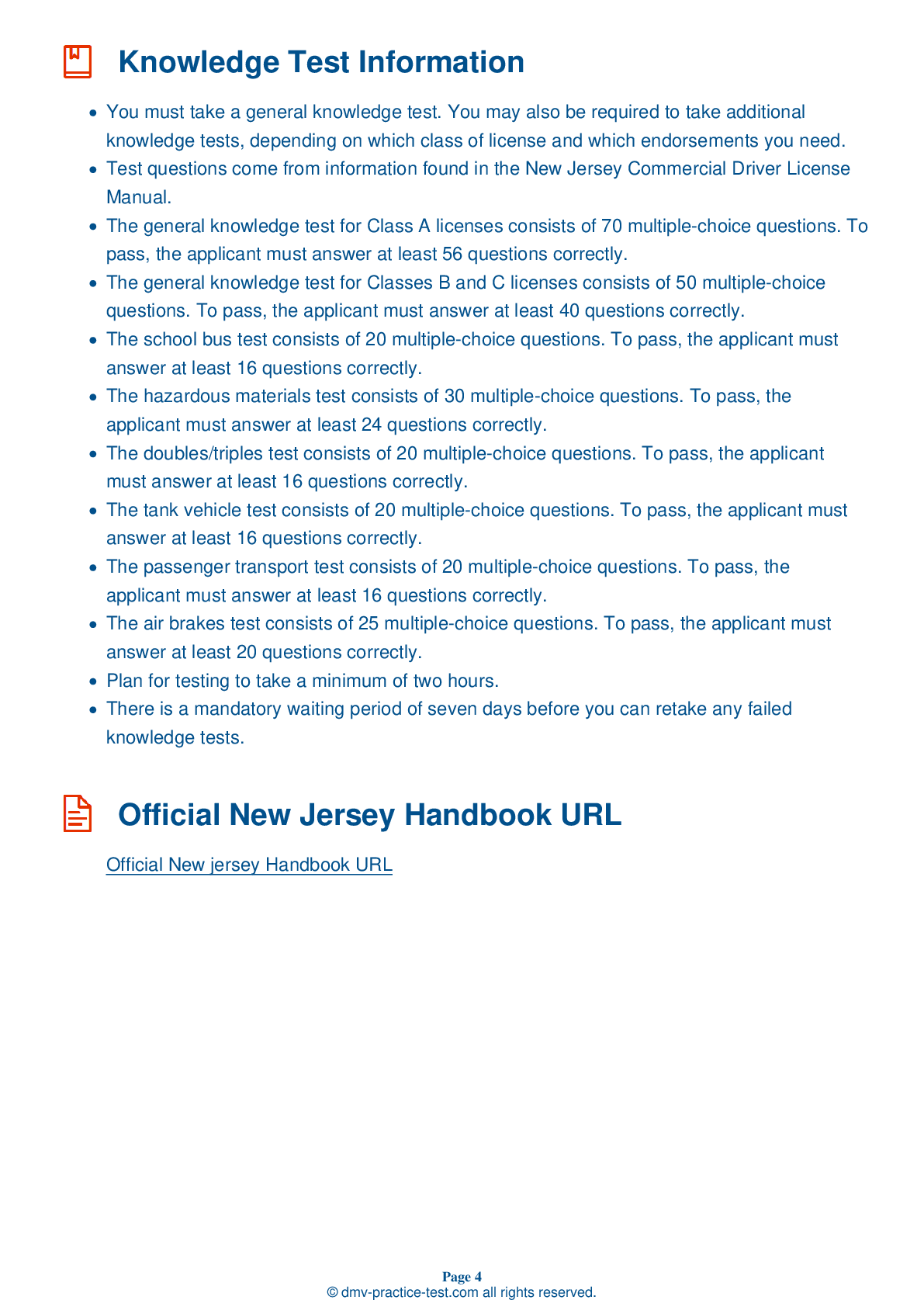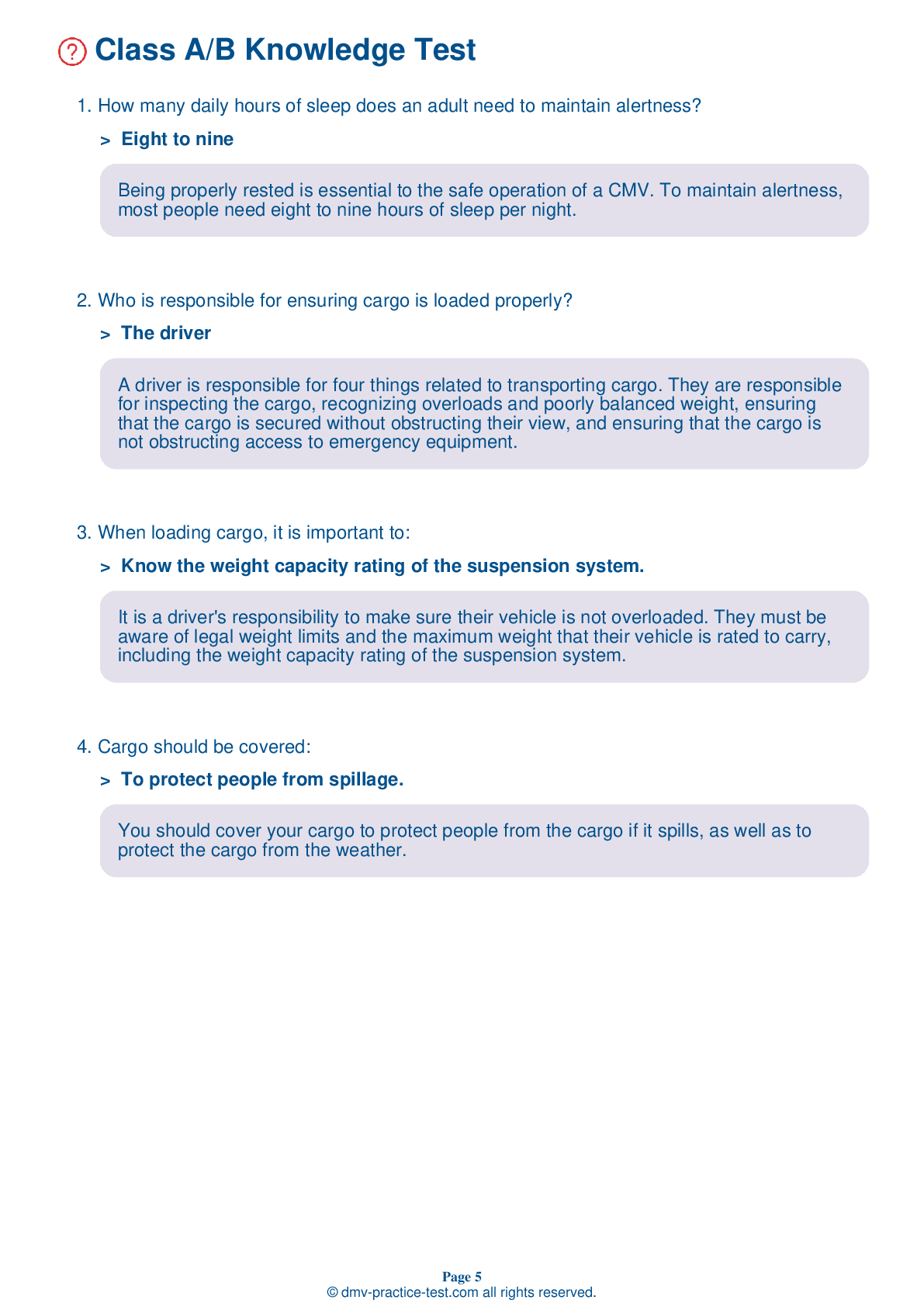Double #2
Double Triple Test | New Jersey 2025 #2 Page 2 of 3
Train for FREE with our New Jersey CDL double triple practice test online. The official exam test consists of several obligatory parts, with all of them checking your knowledge of different blocks of road rules. If you need to obtain a NJ CDL double triple license in 2025, practice as much as possible. Free sample tests published on our website will help you check and improve your knowledge and boost your grades. Please bear in mind that DMV requirements may vary from state to state.
20
16
20
8 . A thin layer of ice that forms on road surfaces is called:
Blue ice.
Black ice is a thin layer of ice that is clear enough for the road surface to be seen through it. A road covered in black ice may look like it is merely wet. You should be very careful when temperatures are below freezing and the road looks wet.
9 . Which of the following is required emergency equipment?
Tape
All commercial motor vehicles are required to be equipped with the proper emergency equipment. This may include spare electrical fuses; three red reflective triangles, six fuses, or three liquid burning flares; and at least one properly charged and rated fire extinguisher.
10 . When entering a curve, you should:
Take the vehicle out of gear.
It is important to take turns and curves at a safe speed. You should always downshift before entering a curve.
11 . Which of the following is not an example of a distracted person that motorists should be worried about?
A person sitting on a bench waiting for a bus
You should be cautious when you are near people who are not paying attention to the road. Be wary of drivers who are engaged in conversation with passengers, children near the road, and road workers.
12 . How many daily hours of sleep does an adult need to maintain alertness?
Four to five
Being properly rested is essential to the safe operation of a CMV. To maintain alertness, most people need eight to nine hours of sleep per night.
13 . If you are being tailgated, you should:
Allow the vehicle to pass.
If someone is tailgating you, it is a good idea to open up the space ahead of your vehicle to make it easier for the driver to pass you. Increasing your speed is not a good idea because the driver may continue to tailgate you at the higher speed, only increasing the danger.
14 . Belts in the engine compartment should be:
Easy to slide off.
When inspecting your vehicle's engine, check the belts for tightness and excessive wear. The amount of "give" that is safe for each belt in a given engine will vary, so learn what is appropriate for your vehicle.
2025 New Jersey | Frequently Asked Questions
To acquire a CDL Hazmat endorsement in New Jersey, you must first have a valid CDL. Then, pass the Hazardous Materials Endorsement Knowledge Test at a Motor Vehicle Commission agency. You'll also need to undergo a TSA security threat assessment, which includes fingerprinting and a background check. Finally, submit the TSA approval to the MVC.
To obtain a CDL Hazmat license in New Jersey, you must already possess a Commercial Driver's License (CDL). You must also pass a Hazardous Materials knowledge test, submit to a federal security threat assessment, including fingerprinting and background check. In addition, you must be at least 21 years old and have no disqualifying criminal offenses.
When applying for a CDL Hazmat endorsement in New Jersey, you need to provide a valid CDL, proof of U.S. citizenship or appropriate immigration status, and identification documents. You will also need to complete the Hazardous Materials Endorsement Application and pass the Hazmat Knowledge Test. After passing a TSA security threat assessment, submit the approval to MVC.
Yes, there is a dedicated written test for the CDL Hazmat endorsement in New Jersey. It's known as the Hazardous Materials Endorsement Knowledge Test. This test assesses your understanding of transporting hazardous materials. You must pass this test before you can receive your Hazmat endorsement.
The written test for the CDL Hazmat endorsement covers a range of topics related to hazardous materials. These include identifying different types of hazardous materials, understanding shipping papers, using placards and labels, loading and unloading hazardous materials, handling emergencies, and following safety procedures. The test is designed to ensure drivers can safely transport hazardous materials.
Yes, there are extra charges associated with acquiring a CDL Hazmat endorsement in New Jersey. These include a fee for the knowledge test, a fingerprinting fee, and a TSA security threat assessment fee. The exact cost may vary, so it's recommended to check with the New Jersey Motor Vehicle Commission for current fees.
Yes, to obtain a CDL Hazmat endorsement in New Jersey, you must undergo a federal background check and fingerprinting. This is mandated by the Transportation Security Administration (TSA) to ensure that hazardous materials are transported safely. The TSA will review criminal, immigration, and mental health records as part of this process.
Yes, specialized training is required for the CDL Hazmat endorsement. Applicants must pass a written test that covers hazardous materials regulations and safety procedures. Additionally, they must undergo a TSA security threat assessment, which includes fingerprinting and a background check. There is no separate certification, but the endorsement is added to your CDL upon passing the test.
No, you cannot legally transport hazardous materials without a valid CDL Hazmat endorsement in New Jersey. This endorsement demonstrates that you have the necessary knowledge and training to handle and transport hazardous materials safely. Transporting hazardous materials without the proper endorsement can result in hefty fines and penalties.
Yes, you can add the Hazmat endorsement to your current CDL license in New Jersey. You don't need a new application for the CDL itself, but you do need to pass the Hazmat knowledge test, submit a fingerprint-based background check, and pay the associated fees to get the endorsement.



